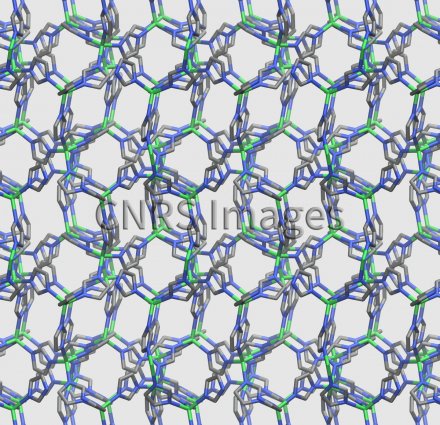Production year
2017

© François-Xavier COUDERT / IRCP / CNRS Images
20170124_0002
Représentation en image de synthèse de la structure moléculaire cristalline du matériau ZIF-4, à température ambiante. Il est composé d'édifices moléculaires en forme de pyramide, dont chacune consiste en un atome de zinc entouré de quatre molécules organiques cycliques, appelées imidazolate. Il fait partie de la classe des réseaux métallo-organiques (Metal-Organic Framework, ou MOF), qui ont la particularité d'avoir une porosité exceptionnelle. Cela leur permet de stocker et de séparer de grandes quantités de gaz, ou d'agir comme catalyseur de réactions chimiques.
Le matériau ZIF-4 a la capacité de garder ses propriétés de porosité à l'état liquide, puis à l'état vitreux, ce qui constitue un cas unique à ce jour parmi les MOF, dont la structure cristalline implique habituellement qu’ils soient produits sous forme de poudre, ce qui les rend difficiles à stocker et à utiliser pour des applications industrielles.
The use of media visible on the CNRS Images Platform can be granted on request. Any reproduction or representation is forbidden without prior authorization from CNRS Images (except for resources under Creative Commons license).
No modification of an image may be made without the prior consent of CNRS Images.
No use of an image for advertising purposes or distribution to a third party may be made without the prior agreement of CNRS Images.
For more information, please consult our general conditions
2017
Our work is guided by the way scientists question the world around them and we translate their research into images to help people to understand the world better and to awaken their curiosity and wonderment.